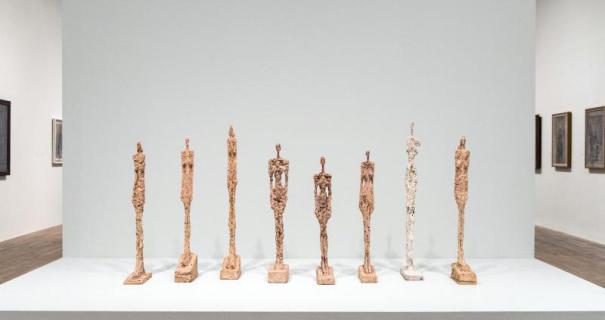Top: The Westbury Horse, Eric Ravilious (1939)
Bottom: Barrage Balloons at Sea, Eric Ravilious (1940)
Despite being widely considered as one of the best British
watercolourists of the 20th century and the most significant wood
engraver of his generation, I suspect that the name Eric Ravilious is still not
widely known outside of the UK, or for that fact, within it either. I have to confess that my knowledge about him
and his peers was very limited, so I was much looking forward to finding out
more in this exhibition. Eric Ravilious
(1903-1942) was an English painter, designer, book illustrator and wood
engraver, most known for his watercolours of the South Downs and other English
landscapes which had a modernist sensibility.
He grew up in East Sussex and studied at the Royal College of Art in
London, where between 1924-1925 he was taught by renowned British surrealist
painter and First World War artist, Paul Nash, who had a profound influence on
his work. Ravilious also served as a war
artist in the Second World War and died when the aircraft he was in was lost
off Iceland in 1942.
Top: Sussex Church, Eric Ravilious (1924)
Bottom: Island, Eric Ravilious (1935)
This charming exhibition shines a light on a fascinating
(and somewhat overlooked) period in 20th century British art and
considers the professional and personal relationships of Ravilious and his group
of artist-designer friends (which included Barnett Freedman, Edward Bawden and
Douglas Percy Bliss), from their first meeting at the Royal College of Art in
1922, through to the outbreak of the Second World War. It examines their relationship with modernism
and how they revitalised British design in the 1930s.
Top: Spring, Tirzah Garwood (1926)
Bottom: Summer, Tirzah Garwood (1927)
“Ravilious & Co” also casts a new light on the
creativity of the women within the friendship group and includes newly
discovered work by Ravilious’ wife, Tirzah Garwood, along with watercolours,
engravings and illustrations by Helen Binyon, the artist’s mistress and
confidente. It also includes never
before exhibited early wood engravings by Enid Marx (who went on to design
iconic textiles for the London Transport Board and who was the first female
engraver to be designated as a Royal Designer for Industry), as well as a range
of fabric, textile and wallpaper designs by Diana Low and Peggy Angus, two
other important contributors within the group.
Top: Barcombe Mill Interior, Tirzah Garwood (1927)
Bottom: Helen Binyon and Eric Ravilious at Furlongs, Peggy Angus (c. 1940)
I am a huge fan of woodcut printing, so just to see such
exquisite examples by Ravilious, Garwood and Marx was a treat by itself. But to learn more about this period of British
art was also very enlightening. Despite
the impact these artists had on British design, within art history narratives
they are almost a lost artistic generation, sandwiched in history as they were
between their Bloomsbury and Vorticist predecessors and then figurative
painters such as Frank Auerbach, Lucien Freud and Francis Bacon, who dominated
the art scene following the Second World War.
It is perhaps for two reasons that this has happened. In mainly capturing everyday scenes and
details from English life, the work of Ravilious and his peers could be seen as
too genteel and provincial compared to their more avant-garde modernist
predecessors and emotionally devoid when compared to Auerbach & Co. I suspect though that it was the very
successes that they achieved in design and that they earnt their living through
commercial endeavours rather than by private commissions and exhibiting in
galleries, which has ultimately relegated them within art history hierarchies.
Top and Middle: Design for upholstery for London Transport, Enid Marx (c. 1940)
Bottom: 'Travel' pattern for Wedgwood dinner service, Eric Ravilious (c. 1938)
“Ravilious & Co: The Pattern of Friendship. English Artist Designers 1922-1942” considers
these possibilities with a comprehensive and absorbing display of work by a
group of artists whose practice was indeed formed by modernism, but who chose a
discipline which ultimately embraced the decorative over the avant-garde.
Tirzah Garwood and Eric Ravilious painting a mural at the
Midland Hotel, Morecambe (1930)


























































